Specifications:
Displacement 2,275 t.(lt), 5,861 t.(fl)
Length 423' 10"
Beam 57
Draft 9.9'
| Click On Image For Full Size Image |
Size | Image Description | Contributed By |
|
|---|---|---|---|---|
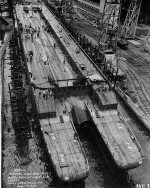 |
118k | AVC-1 unofficially known as the "Silver Queen". This view shows the stern of the vessel, where the seaplane would be hauled aboard up a ramp. The vessel was laid down on a disused shipway at Philadelphia Navy Yard on 29 May 1939. This photo was taken on launching day, 17 August 1940. US Navy photo. |
Robert Hurst | |
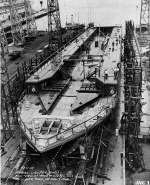 |
117k | AVC-1 on launching day, 17 August 1940, when the ship was 72% complete. She was launched without ceremony; the launching was probably motivated by the need to clear shipways for wartime construction, rather than a need for this experimental barge. The vessel was placed "in service" 17 December 1941, at which point experimental seaplanes were hardly a priority. US Navy photo. |
Robert Hurst | |
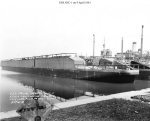 |
99k | AVC-1 at Philadelphia Navy Yard, 4 January 1941, while the catapult was being installed. This stern view shows part of the ramp up which the Martin XPBM-2 Mariner was raised before being placed on the catapult. The ships in reserve on the right are Maumee (AO-2) and Bridgeport (AD-10), which the Navy decided not to return to service in World War II. Bridgeport would serve during World War II as the US Army hospital ship USAHS Larkspur and later as the US Army transport USAT Bridgeport. US National Archives Photo from RG-19-LCM. |
Robert Hurst and Mike Green, courtesy shipscribe.com | |
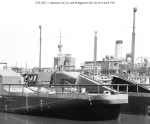 |
121k | |||
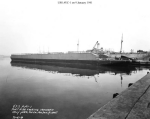 |
61k | AVC-1 at Philadelphia Navy Yard, 9 January 1941, about a week before being placed in service. US National Archives Photo from RG-19-LCM. |
Robert Hurst, courtesy shipscribe.com | |
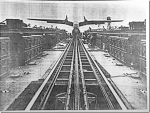 |
73k | AVC-1 on 2 June 1942 with the Martin XPBM-2 Mariner (Bu.Aer. # 1247) on the car of the XH-111 catapult. This aircraft was a Martin PBM-1 Mariner modified for long-range operations with additional fuel tanks and a reinforced airframe to permit catapult launching. Only the prototype was built, and after catapult trials it served as a static test article at Philadelphia until stricken in June 1944. US Navy photo # NH 94608 from the collections of the US Navy History and Heritage Command. |
Robert Hurst | |
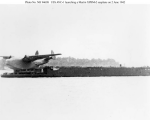 |
40k | AVC-1 on 2 June 1942 with the Martin XPBM-2 Mariner (Bu.Aer. # 1247) at release point from the launching car of the XH-111 catapult. US Navy photo # NH 94608 from the collections of the US Navy History and Heritage Command. |
Robert Hurst, courtesy shipscribe.com | |
 |
21k | AVC-1 was intended to have diesel propulsion, but installation of her engines was canceled along with the seaplane program. Her catapult machinery proved to be unreliable and troublesome. She was used for catapult trials on an intermittent basis, and spent several periods in reserve. The odd vessel was sold in 1956, shortly before USN abandoned seaplanes completely. Although some sources report the barge was scrapped in 1956, she survived at least through the mid-1970's under the name Pulpwood #1, apparently as a pulpwood barge. US Navy photo. |
Robert Hurst | |
There is no DANFS history available for AVC-1 at NavSource
| Commanding Officers | |||
| 01 | LT. Butler, Frank Eric Paget, USN | 3 May 1945 - 13 August 1947 | |
Crew Contact And Reunion Information
U.S.Navy Memorial Foundation
Additional Resources and Web Sites of Interest
Shipscribe.com
| Back To The Navsource Photo Archives Main Page | Back To Yard and District Craft Type Index | Back To The Catapult Lighter Index |
| Comments, Suggestions, E-mail Webmaster. |
|
This page is created and maintained by Gary P. Priolo |